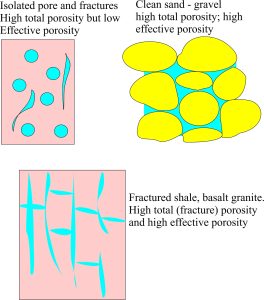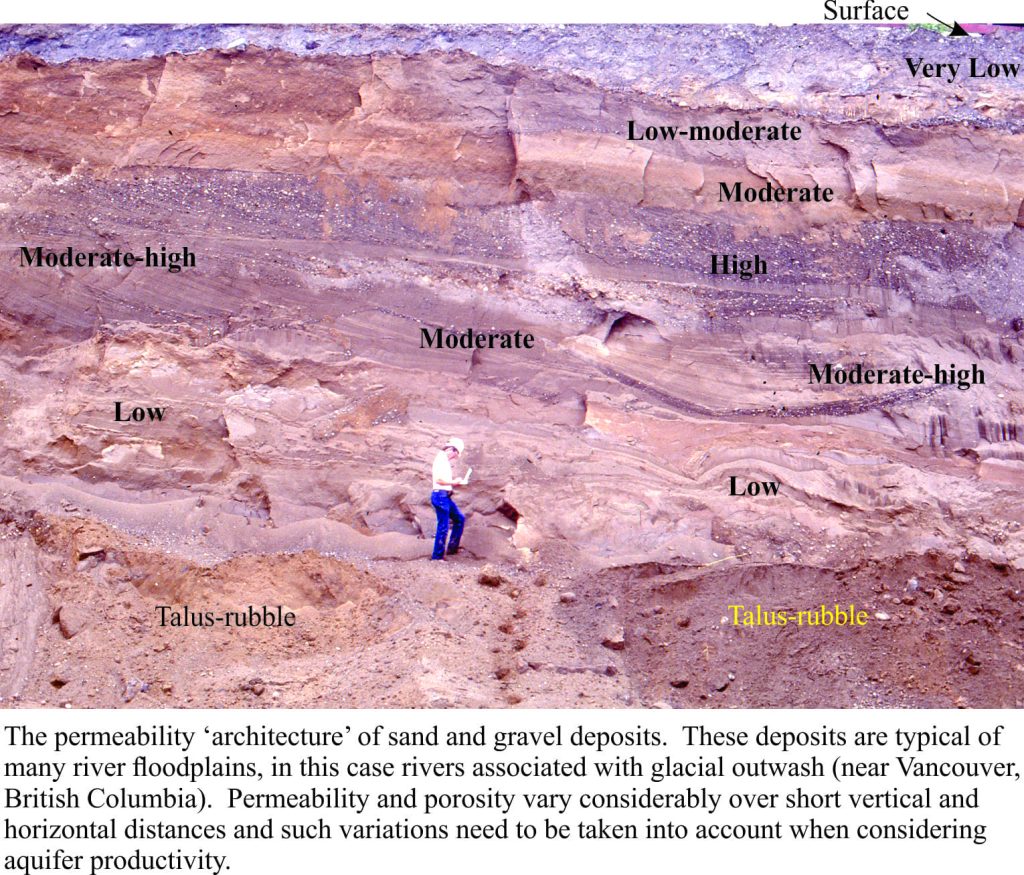2nd in the Series on Groundwater
We commonly differentiate the solid earth in terms of its architecture, whether it is the foundations of great mountain ranges, or the solidified magmas that underpinned ancient volcanoes. All rocks, whether layered sedimentary rocks or massive intrusive granites, have unique characteristics that define their physical, chemical and biological make up – their architecture.
WE can also think of groundwater in terms of its own architecture. The productivity of an aquifer depends first and foremost on its porosity and permeability. We can use these two fundamental properties to define the architecture of earth materials.
Porosity – the part of a rock that isn’t
Technically, porosity is the void, pore and fracture space within rocks and sediments. Sand and gravel deposits for example contain space between grains. The amount of space, or volume is usually quoted as either a percentage or fraction of the total sample volume; clean, newly deposited river, dune and beach sands typically have pore space volumes of 30-40% of the total volume; this means that 30-40% of the sediment volume can be filled with water (or other fluids). A simple experiment to demonstrate sand porosity is shown in the images below. Porosity decreases as the sand is gradually compacted; porosity also decreases as pores are filled with rock-forming cements like calcite and quartz
We need to make the distinction between total porosity (i.e. pore space plus all the really tiny nooks and crannies), and effective porosity which is the amount of pore space available for water to actually flow through the sand (or any porous deposit). Effective porosity is always less than total porosity.
Permeability
Permeability is a measure of how easy it is for water (any geofluid) to flow through the pores in sediment or rock; high permeability usually equates to faster rates of flow (and increased productivity). There is a good correlation between high porosity and high permeability in clean sand-gravel deposits, but this relationship tends to break down if the deposit contains mud and silt. At the other extreme, newly deposited muds have very high porosity (upwards of 70%) but very low permeability; as the mud is compacted both porosity and permeability decrease abruptly. Fracturing of hard rock can also produce excellent porosity and if the individual fractures are connected the permeability will also be high.
Two measures of permeability are in common use. The oil industry tends to use a unit called the Darcy, named after Henri Darcy who experimentally determined the flow characteristics of water through sand. A Darcy has units of area (m2, ft2) and depends only on the porous sand or rock (millidarcy is most commonly used). The oil industry generally finds this expression for intrinsic permeability (k) more useful than its counterpart for groundwater (described below), because exploration and production deal with oil, gas and aqueous fluids where density and viscosity vary.
The expression for permeability used in groundwater studies is hydraulic conductivity, that has units of distance/time (m/s, or cm/s). Unlike intrinsic permeability, hydraulic conductivity depends on both the porous medium and the fluid (its dynamic viscosity and density). So for a porous sand, the value of K will be different for water and, say maple syrup. This expression of permeability is important for remediation of groundwater contaminants such as volatile hydrocarbons (e.g. gasoline) or dense hydrocarbons (oil) that have different viscosities and densities compared to water. For groundwater, K is also useful because it actually has the units of velocity (m/s); by taking both porosity and K into account we can calculate groundwater flow rates. Mathematically, both intrinsic permeability k and hydraulic conductivity K are proportionality constants where k is related to K by the fluid density and viscosity.
Porosity-Permeability architecture
River flood plain and glacial outwash deposits like those shown in the photo below, form some of the most common shallow aquifers. The aquifers consist mostly of sand and gravel, but muds and peats may also be intersected during well drilling. Permeability, or hydraulic conductivity tends to be high overall but there can be considerable variation, as shown in this example. Having some knowledge of the permeability architecture (in addition to other groundwater data) can help decisions about water-well placement.






Pingback: click here
Thanks for that